8 A World of Music
Introduction
In our last chapter, we discussed how different music from around the world inspired some impressionist composers. In this chapter, we’ll sample some music traditions from around the world. In our next chapter, we’ll briefly examine how some of these different music traditions have inspired popular music.
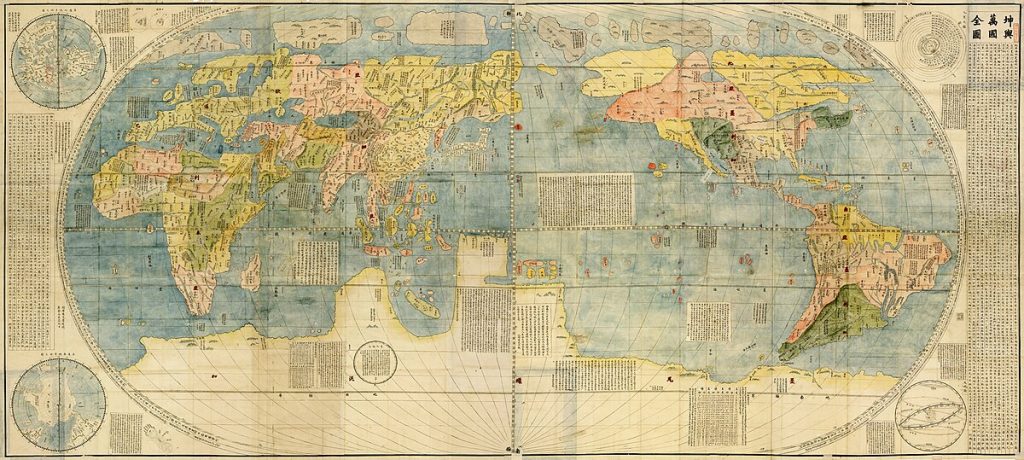
This is by no means an exhaustive collection of music from around the world. At the same time, some sections being longer than others does not indicate that it is of greater importance; rather, it reflects a greater abundance of available open material. We could spend an entire course focusing on world music and still have countless traditions to explore. This chapter—even any section of this chapter—could be expanded into a whole book. This chapter provides a sample of other music traditions which have informed music in this course and provides a chance to further explore. As you read, think about which music cultures you find especially fascinating, and see what else you can learn about them.
It’s worth noting how various examples from around the world can differ from what we’ve looked at earlier, or Western Classical Music.
|
Western Classical Music |
Music from around the World |
|---|---|
|
Pitch is fixed; harmony is present and helps propel the music. |
Pitch can be flexible, as musicians in various cultures bend and slide between notes; there is generally less emphasis on harmony. |
|
Polymeter and polyrhythm are less common. |
In various cultures, polymeter and polyrhythm are more common.
|
|
Musicians regularly play music from written notation. |
In various cultures, musicians regularly improvise and learn from an oral tradition. |
|
Large ensembles require a conductor. |
Large ensembles are often led by a musician playing in the group. |
|
A single person created the music, which is often considered a work of art. |
In some cultures, a group often collaborated on music, which is often considered a part of everyday life. |
Balinese Gamelan
Bali is one of many thousands of islands between the Pacific and Indian Oceans that make up the Republic of Indonesia. Other islands of Indonesia include Java, New Guinea, and Sumatra. One of the most prominent Indonesian music genres is gamelan, a traditional Indonesian ensemble of percussion instruments, often bronze, that can accompany dance, plays, religious ceremonies, and community events. The instruments can be very ornate.
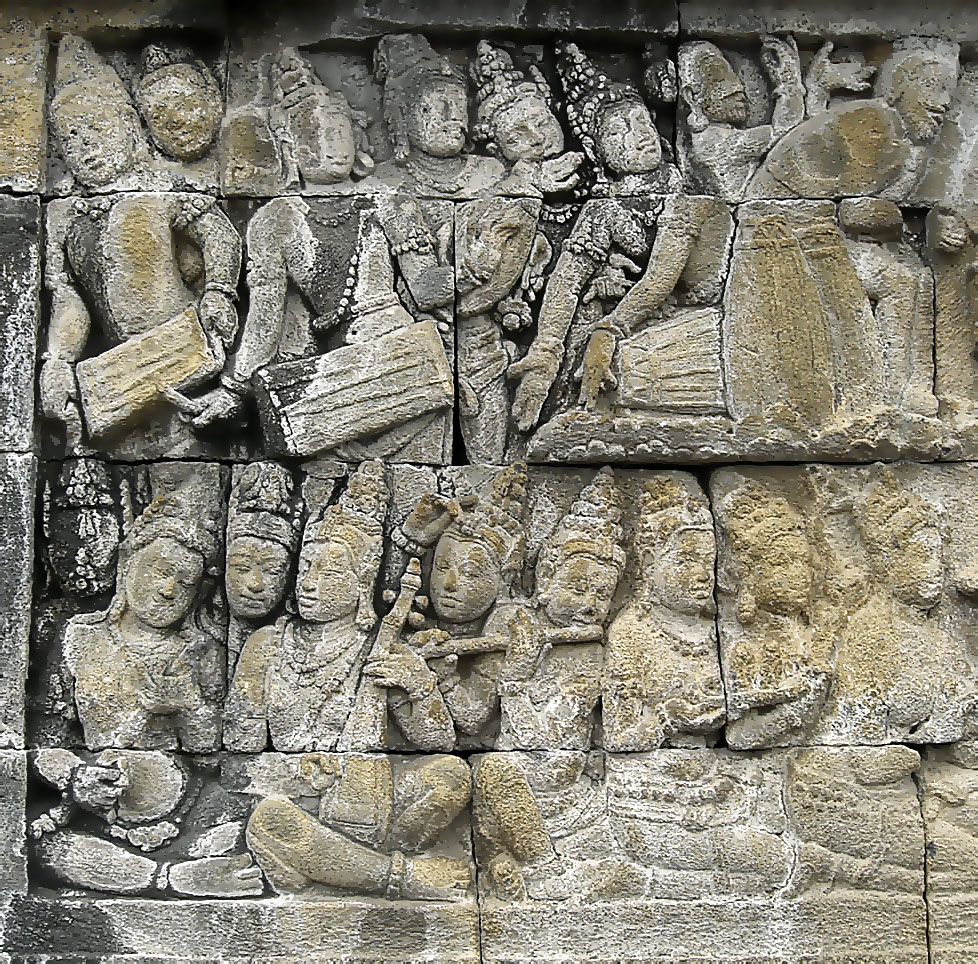
Gamelan compositions are based on a single melody, and pieces are learned through oral traditions. One can often hear different interlocking layers of music in gamelan between the different melodies and fast figures, with gongs prominently appearing at key points in the structure of the piece.
Bali, one of Indonesia’s many islands, is predominantly Hindu with a population of two million people. Music is linked to both daily routine and religion in everyday life in Bali, and events of all kinds include gamelan performances. Gamelan is a percussion ensemble with struck bronze keys, gongs, and cymbals, sometimes with flutes and singers. While Western music is often goal-oriented, Gamelan is cyclical; gongs mark the beginning and end of main melodies which are repeated, and other instruments elaborate this melody. Each island of Indonesia has its own style of gamelan music, and the Balinese kebyar gamelan is among the most flashy and virtuosic.
Ex. 8.1: Balinese gamelan performance, “Kapi Raja”
The entire ensemble has the opportunity to show off their incredible abilities as their parts interlock in a complex interweaving of metal sounds.
Gamelan performance requires and conveys a considerable sense of cooperation and collaboration. Generally speaking, performers—even with virtuosic parts—strive to be part of the tapestry of music lines rather than standing out as soloists. Furthering the sense of cooperation, some of the larger gongs require more than one performer, and two musicians might play the same part on different sets of instruments to create a shimmering sound.
Bonus Video: Gamelan performance with dancers, Tari Cendrawasih
Gamelan is often used to accompany rituals or other performing arts, like shadow puppetry or dance. To experience a virtuosic Gamelan ensemble performing with dancers, watch the following video:
YouTube Video: “Tari Cendrawasih” by Krisna Saptanyana
The Bayaka of Central Africa
The Bayaka people live in the rainforests of the Central African Republic and the Democratic Republic of the Congo. They are hunter-gatherers in the rainforests and men and women are equals in their society without social hierarchy. This lifestyle—and their style of singing—goes back thousands of years, with UNESCO describing their oral tradition as a “masterpiece of the oral and intangible heritage of humanity.”
Ex. 8.2: Bayaka women, Congo, polyphonic singing
This song that we examined in Chapter 1 as an example of polyphony is characteristic of Bayaka music, combining polyrhythm and polyphony. There are simultaneously occurring melodies and rhythmic patterns. It also features yodeling—singing without words and alternating between chest voice and head voice.
Brazil
Samba, the most popular traditional music in Brazil, emerged in working-class neighborhoods after the escola de sambas (social clubs where samba was played) formed in 1928. They played for Carnaval—festivities similar to Mardi Gras. During Carnaval, escolas compete for the best samba performances. In samba, we hear Portuguese influence in the melodies and harmonies and African influence in the call and response and percussion.
Bossa nova developed from samba, and translates loosely as “new thing.” It started as more of a middle-class entertainment. Influential Brazilian composer and musician Antonio Carlos Jobim, who popularized bossa nova throughout the world and wrote around 400 compositions said, “Bossa nova is serene, it is love and romance, but it is restless.”

Bonus Video: Antonio Carlose Jobim, The Girl from Ipanema
This is Jobim’s most widely-known song which won a Grammy for Record of the Year. Against the consistent and recurring AABA form is a shifting sense of syncopation; different soloists are featured throughout the work, but each soloist conveys a cool, laid-back, sultry, and smoky mood to their parts.
YouTube Video: “Astrud Gilberto and Stan Getz – The Girl From Ipanema (1964) LIVE” by iTubeNL
Cajun Zydeco
Cajun Zydeco is another form of American folk music that grew from European roots. This style was developed by Cajuns, the descendants of Acadian immigrants (French speakers from Acadia), who settled in the swamps of Southwest Louisiana, later to be called Acadiana.
Most Zydeco music is vocal and is almost always designed for dancing. Instruments were traditionally acoustic since electricity is not easy to come by in Acadiana. Instruments include upright bass (later the electric bass), drums, accordion, fiddle, guitar, and solo vocal. The words are almost always in French, the language of the Cajun settlers.

Bonus Video: Clifton Chenier & Louisiana Ramblers, Tu Le Ton Son Ton
This a live performance from 1971. Accordion player Clifton Chenier was called the King of Zydeco. This piece combines Creole influences with American R&B.
YouTube Video: “Tu Le Ton Son Ton – Clifton Chenier & Louisiana Ramblers live 1971” by Rowland108
Celtic (Ancient Scotland, Ireland, and a Small Portion of France)
The Celts refers to a diverse group of people who lived during the Iron Ages in what is now Great Britain and Western Europe. In addition to speaking Celtic languages, these people shared a common musical heritage, one that is still used by their descendants. Celtic music is often recognized by its instrumentation, which combines bagpipes, various stringed instruments, and drums. Celtic music also has a distinctive melodic style, with wide leaps that outline the harmonies of the song and create a feeling of jubilance.
Bonus Video: Alan Stivell, Suite Irlandaise / The King of the fairies
YouTube Video: “Alan Stivell en Concert – 1972 – Suite Irlandaise / The King of the fairies” by tehelde87
Bonus Video: Celtic Woman, Téir Abhaile Riú
Celtic Woman is a modern performance group that focus on music from the Celtic tradition.
YouTube Video: “Celtic Woman – Téir Abhaile Riú” by CelticWomenVEVO
China
China is one of the oldest and most culturally rich civilizations, responsible for inventions like printing, paper, gunpowder, and the dictionary. The country has a rich tradition of literature connected to philosophy, religion, poetry, novels, and science. In modern times, the People’s Republic of China is geographically one of the largest countries in the world and holds the world’s largest population. Cultural practices and languages vary throughout the country. With its long history and vast population, it’s no surprise that there are many different musical styles and traditions.
In the sixth century BCE, Confucius, a Chinese philosopher, described music as valuable for an orderly society and being in harmony with nature. Chinese mathematicians knew mathematical principles of generating pitches during the third century BCE, court orchestras of twenty-plus performers played in courts of the seventh through ninth centuries CE, and Chinese opera emerged about three hundred years prior to Europe.

Peking Opera has been an especially prominent genre of music-drama, enjoying popularity among the common people and the upper class in China, and throughout the world. The operas are typically about the relationships of the characters—social and romantic—and battle.
Peking Opera is known for its characteristic and stylized gestures and movements. Singers sing with a nasal sound and are accompanied by wind, string, and percussion instruments. One of the percussionists typically serves as the conductor by setting the beat.
Bonus Video: Peking Opera
Generally, Chinese music focuses on melody instead of harmony, and often uses microtones—pitches between the notes of a Western piano. One uniquely Chinese instrument is the erhu, a bowed, two-stringed instrument with a snakeskin-covered soundbox.
YouTube Video: “Peking opera” by UNESCO
Ex. 8.3: Chinese erhu and yangqin performance, “Honghu People’s Wish”
This piece is taken from the Chinese modern opera Red Guards on Honghu Lake, first performed in 1956 and based on events from 1930. In this story, the heroine is the leader of the Red Guards. She was put in prison after a battle, and in her cell, she sings about her journey in life: the ups and downs, and hope for a better future. This piece was arranged for the erhu in 1970. The erhu is accompanied by the yangqin, a Chinese stringed instrument played by “hammers,” flexible bamboo covered in rubber.
Cuba
Cuba, an island nation about 100 miles from Florida, is a great example of the fusion between African and European kinds of music, with a relatively equal distribution of various ethnicities: Black, White, Indigenous, and Mulatto (people of mixed European and African ancestry). Spanish colonists brought their own music (which already combined European and African elements), some of which we looked at while discussing Ravel and Bizet. For example, Ravel’s Bolero is named after the slow Spanish dance in triple-meter, and Bizet’s Carmen evoked the habanera, a duple-meter dance that originated in Spain and became a distinctly Cuban dance.
This mixed with West African drumming, as heard in the religious music of Santería. A common style of popular music is son cubano, “Cuban sound,” dance music with a singer pushing the beat. Since the original days of son cubano, the term has been used to describe a variety of similar genres: rumba, mambo, and salsa.
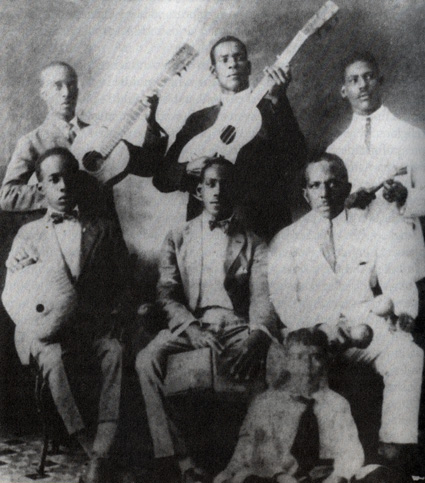
Ex. 8.4: Sexteto Habanero, “Ahora Si”
Sexteto Habanero, which eventually added a seventh member and was renamed Septeto Habanero, was formed in 1920 and helped popularize son cubano. Original performers and instrumentation included Guillermo Castillo (guitar and director), Carlos Godínez (tres, a strummed Cuban instrument), Gerardo Martínez (lead vocals and claves, a small and striking percussion instrument), Antonio Bacallao (botija, a jug blown into as a bass instrument), Óscar Sotolongo (square bongó, or pair of Afro-Cuban hand drums), and Felipe Neri Cabrera (maracas, a pair of shakers). You can clearly hear the main melody over the chords and interlocking percussion instruments.
Ghana
In Chapter 9, we’ll examine the influence of African Americans in the Southern United States. Most of their ancestors came as slaves from Western sub-Saharan Africa (modern-day countries like Senegal, Guinea, Ghana, Benin, and Ivory Coast). Generally, throughout Africa, music accompanies everyday life, from travel to work to festivals. While Western music has a clear distinction between performer and audience, music from West Africa is made by the entire community; there isn’t a specified composer, as the music creation was a group contribution.
Bonus Video: Post office in Ghana
In parts of Africa, music can be ever-present, as shown by post office workers who make the mundane task of stamping letters rhythmically interesting.
YouTube Video: “02 West Africa Ghana, post office” by Ha Pham
While European/Western classical music is known for complex harmony, West African music is known for complex rhythms. Each musician can have their own independent rhythm and meter, creating polyrhythm and polymeter. Drums are very common instruments for leading music and dance, although flutes, harps, bells, whistles, and trumpets are also used. One instrument most unique to Africa is the talking drum, where the performer can alter the pitch of the drumhead to make it “speak.” As we’ll see in other non-Western cultures, the pitch can be flexible and singers will slide and bend the pitch.
Ex. 8.5: Ghanaian traditional music performance
This field recording (a recording made among everyday people, not in a recording studio or concert hall) captures a solo voice, later joined by more voices, accompanied by interlocking rhythms.
Japan
Japan today is an interesting juxtaposition of the old and new. It’s a technologically modern city with a strong cultural history. Western pop and classical music are regularly heard, but so is traditional Japanese music.
Ma is a key concept in Japanese art, and can be translated to words like “space,” “rest,” and “timing.” In contrast to the hustle and bustle of everyday life, ma conveys ideas of silence, contemplation, and open space. Musically, ma is the space or silence between sounds and an opportunity to reflect on the performance. Japanese music is often drawn out and without a pulse, similar to Gregorian Chant from Chapter 2.

Bonus Video: Koto Performance
The koto is a thirteen-string plucked instrument that was initially played in the royal courts, but like the piano of nineteenth-century Europe, later appeared in middle-class homes. The following video includes Kazue Sawai, who has been called the Jimi Hendrix of the koto:
YouTube Video: “Kazue Sawai Plays Midare (JAPANESE KOTO)” by Harris Stevens
Bonus Video: Yoshida Brothers
The Yoshida Brothers found success playing the traditional three-stringed shamisen while incorporating Western pop sounds.
YouTube Video: “YOSHIDA BROTHERS — Modern” by oqd0bpo
Ex. 8.6: Japanese shakuhachi performance, Prelude to Kumoi Jishi
This solo piece is performed by the shakuhachi, a bamboo flute. The instrument was popularized by wandering priests who used the flute for meditation; as the instrument grew in popularity, people played it for secular music. While this piece is slow, it was not meant for solemn mediation. Performance situations can range from begging to wedding celebrations. As you listen, note how the bursts of air that begin each phrase are part of the music, and listen for the ma—that silence between phrases.
You can read more information about this piece here:
Hélène Seiyu blog post about Kumoi Jishi
Bonus Video: Kabuki
Kabuki is a form of theater that developed in the 1600’s. It includes visually distinct costumes and makeup and tells stories of moral issues and historical events.
YouTube Video: “Kabuki Theatre” by UNESCO
North Indian Hindustani Music
Since the mid-twentieth century, Western audiences have taken to Indian film and music. Hindi cinema (“Bollywood”) is a worldwide phenomenon, known for melodramatic stories and complex song-and-dance numbers. Ravi Shankar helped put Indian culture in the mainstream in 1967 with his performance at the Monterey International Pop Music Festival.
Like the West, India has a strong tradition of classical music. Musicians specialize in improvisation and spend years studying with a guru in their development. Styles differ between Northern and Southern India, but both use raga—a concept similar to Western scales, but can involve more specific and complex patterns and has a more specific mood or effect than the Western major or minor scales—and tala—a repeating rhythmic pattern that can be complex and forms the rhythmic foundation for Indian classical music. Hundreds of talas and thousands of ragas exist.
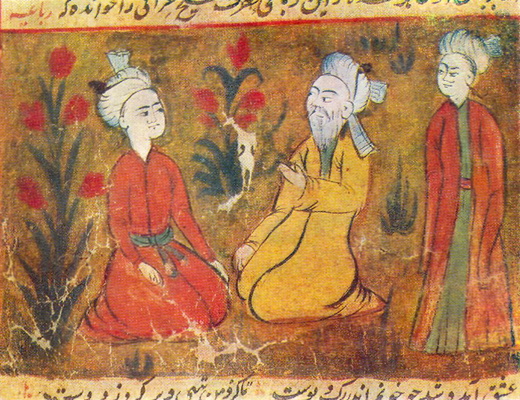
Indian music can be particularly spiritual. Sitarist Ravi Shankar said “We view music as a kind of spiritual discipline that raises one’s inner being to divine peacefulness and bliss. The highest aim of our music is to reveal the essence of the universe it reflects…. Through music, one can reach God.”
Indian classical music generally has three layers: a drone that plays throughout the background, rhythmic improvisation, and melodic improvisation. The tanpura, a plucked instrument with four or five strings, plays a continuous drone. The sitar, a large stringed instrument, plays the melody. The tabla, a pair of hand drums, provides the rhythmic accompaniment. During a performance, the sitar and tabla performers follow each other’s ideas, and as the performance continues, the notes can become faster and the sitar can use more of the extremes of its range.
Bonus Video: Shankar, Live at 1967 Monterey Festival
This iconic example of North Indian classical music is played by Ravi Shankar on the sitar, a large strummed string instrument, with Alla Rakha on tabla, a small pair of drums.
YouTube Video: “Ravi Shankar at Monterey Pop (June 1967)” by Afwan Floyd
An Islamic Call to Workshop – Adhan
Islam originated in the seventh century with the prophet Mohammed. A hundred years after Mohammed’s death, Islam grew through Northern Africa into Spain and through the silk trade routes into China. It is one of the three Abrahamic religions, along with Judaism and Christianity, which trace their foundations to Abraham. With 1.6 billion followers, it is one of the largest religions in the world.
Prayer occurs five times throughout the day. The call to worship, or Adhan, is led by a cantor, or lead singer, called a muezzin. This prayer can take place alone or in a mosque with other worshippers, and always faces the direction of Mecca, Islam’s holy capital in Saudi Arabia. It is usually sung in Arabic; the text is always the same, but the muezzin might change the melody.
Ex. 8.7: Islamic call to worship, “Adhan”
While certainly different styles of music, Islamic and Gregorian chant are both monophonic in texture and lack recurring rhythms and meter, creating a timeless quality, and both are melismatic: syllables have multiple pitches, allowing each vowel to float through space. This piece of Islamic chant, however, contrasts Gregorian chant as the singer slides between pitches. This singer was raised in Morocco and now leads this prayer in California.
Jewish Klezmer Music
Klezmer music is traditional Eastern European Jewish folk music played by bands, generally at social gatherings. Today it is often fused with rock, funk, and jazz. Its history can be traced to the Middle Ages in Eastern Europe. “Klezmer” is a Yiddish term derived from the Hebrew words “klei” (tools, instruments) and “zemer” (melody), translating to “musical instruments.” Klezmer musicians have incorporated Yiddish melodies and Jewish and non-Jewish dances (for example, polka, waltz, etc.).
Generally, Klezmer melodies are comprised of 8 or 16 measures in AB or ABC form, repeated with slight variations and with heavy ornamentation. Minor chords are especially prevalent, and pieces might dramatically shift from a minor to a major mode.
Persecution and unrest brought many Ashkenazi Jews from Eastern Europe to the United States around the turn of the twentieth century, where Klezmer music fused with American popular music like early jazz and the music from Tin Pan Alley.
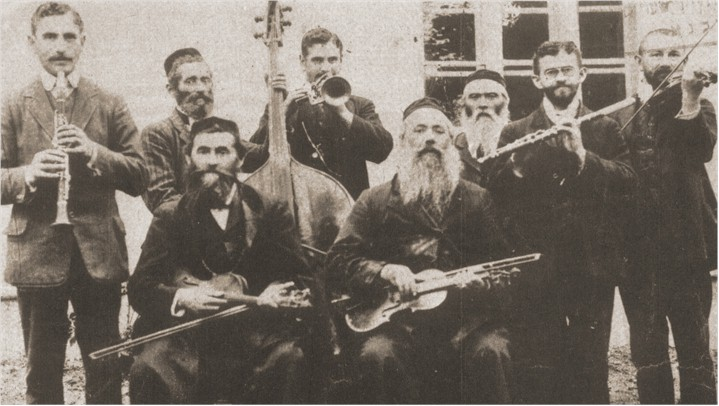
Bonus Video: Fun Taschlich
Taschlich is a Jewish ceremony that involves walking to a nearby body of water to have sins washed away, and the Fun Taschlich is a joyous “returning from the casting away of sin.” This tune has three main melodies, and each is a different, “Eastern” sounding mode that’s similar to, but not exactly like, Western scales.
YouTube Video: “Fun Tashlikh” by The Klezmatics – Topic
Mexican Mariachi
Mexico’s culture is a mixture of the land’s indigenous Mayan and Aztec people and its many centuries spent being ruled by Spain. Mariachi is an especially popular style of music from Mexico now common in the southwestern United States. Mariachi groups originally traveled from one large ranch to another.
The term “mariachi” can refer to a performing group, in the same way that a performing group in Western classical music could be called an “orchestra.” Musically, it has traces of sixteenth-century Spanish music, indigenous Mexican folk, and African music. The instrumentation shows Mariachi’s Spanish influence: violins, trumpets, and guitars. The bass part is played by a guitarrón, which looks like a giant guitar.
The violins and trumpets alternate playing the melody. The guitar player sets the rhythm: clear at first, but then with heavy syncopation—the complex rhythms of the guitar part help add to the excitement of the music.
Ex. 8.8: Mexican mariachi performance, “El Fuereño”
In the performance, the vocalist sings the main melody, but the violins and trumpets also play prominent melodies: sometimes alternating with the singer, sometimes interweaving their melodies with the singer. The guitar and bass propel the piece with their shifting rhythms.
Zuni
The Zuni people are a Native American group and a federally recognized tribe of the United States; for thousands of years, they have lived in the American Southwest. They mostly live today in the Pueblo of Zuni on the Zuni River in New Mexico. Local deserts, mountains, rivers, and forests shape their culture, beliefs, and traditions.
The Zuni are politically hierarchical with a matrilineal kinship. A senior woman leads the household socially, economically, and ceremonially. Religion helps shape their village leadership. Various groups make up the Zuni social and religious system. The Zuni have a Rain Priesthood and a Bow Priesthood.
Zuni leaders organize and perform various private 40-day ceremonies to maintain beauty and harmony in the world. Rain Priesthood ceremonies are exclusive to the Zuni; other religious ceremonies have portions open to people outside of their culture, including dances performed by men and women.
Ex. 8.9: Zuni Rainbow Dance
Zuni music often accompanies dance in ceremonies connected to rain deities. This example includes repeated rhythmic figures performed by percussion and voice.
You can read a news article describing a dance event of the Havasupai, another American Southwest Indigenous culture, and see a performance at this link:
Article: Havasupia dancers to perform at Grand Canyon National Park this Saturday
Bonus Video: Havasupai Ram Dancers Social Round Dance at Indian Festival in Scottsdale 2020
YouTube Video: “Havasupai Ram Dancers Social Round Dance at Indian Festival in Scottsdale 2020” by Chica Arizona
Additional Examples
For a deeper look at some music cultures, consider the World Music Textbook open educational resource.
The website states:
The World Music Textbook is comprised of “chapters.” These are prepared by scholars, musicians, and others and they go through a blind peer review process. They may be short essays, videos, interactive sites, or they may be in other formats entirely. If you have an idea for a contribution, please reach out or consider submitting. In addition to these chapters, the resources page lists many other useful sites from across the internet.
Interested in even more examples from around the world? Consider this non-exclusive list:
First Nations/North American Indigenous Music
Keith Secola
- Keith Secola’s Website
- “NDN KARS” (considered the contemporary Native American anthem and most requested song on Native radio in the US and Canada)
- NDN KARS Remix – Tribe Called Red and Keith Secola
- NDN KARS Remix – Shawn Bernard feat. Keith Secola and Joey Stylez
RPM: Revolutions Per Minute: Indigenous Music Culture (News, Interviews, Music, Podcasts, Artists)
Tribe Called Red
West Africa
E.T. Mensah, king of the popular music genre Highlife
Famoudou Konaté, a djembe virtuoso
Efya, Afro, soul / pop singer
Polynesia
Opetaia Foa’i, founder of the ensemble Te Vaka and featured in the Disney film Moana
Israel Kamakawiwoʻole, Hawaiian ukulele and singing legend
‘Aunty’ Genoa Keawe, influential Hawaiian vocalist
Herbs, a New Zealand reggae band
Argentina
Alberto Ginastera, a composer who studied with Aaron Copland
Astor Piazzolla, prominent tango composer
Mercedes Sosa, nueva canción singer
Power of Soul, a soul/funk band
Japan
Hachiro Kasuga, 1950’s enka (popular music with some traditional Japanese characteristics) singer
Hibari Misora, sang one of the most renown Japanese songs of 20th century
The soundtrack for the video game Civilization 6 takes a fascinating approach that ties in music history and world music. Each civilization has its own authentic folk tune, and as time progresses, the tune evolves to reflect trends in music history. You can read about and listen to the soundtrack at the following links:
- Article: Civ 6’s music evolves alongside your cities, and it’s one of its best features
- Civilization VI Official Game Soundtrack
Attributions
This chapter was adapted from the following OER:
- Understanding Music: Past and Present by N. Alan Clark, Thomas Heflin, Jeffrey Kluball, and Elizabeth Kramer from the University System of Georgia, licensed by a CC BY-SA 4.0 international license.
- Music: Its Language, History, and Culture by Ray Allen, Douglas Cohen, Nancy Hager, and Jeffrey Taylor from the Conservatory of Music at Brooklyn College of the City University of New York, licensed by a CC BY-SA 4.0 international license.
- Native Peoples of North America by Susan Stebbins, licensed by a CC BY-NC-SA 3.0 license.
Traditional Indonesian ensemble of percussion instruments, often bronze.
Two or more different rhythms played at the same time.
Musical texture that simultaneously features two or more relatively independent and important melodic lines.
Two-stringed Chinese bowed instrument.
Popular Cuban music that combines Spanish and African influences.
Two or more different time signatures played at the same time.
Japanese concept of a pause or emptiness.
A bamboo flute used in traditional Japanese music.
A pattern of notes with various associations used as the basis for improvisation in Indian classical music.
A repeating rhythmic pattern that that forms the rhythmic foundation for Indian classical music.
Plucked string instrument with four or five strings each tuned to one tone of the basic scale and plucked to produce a continuous, unvarying drone accompaniment.
A plucked string instrument used in Indian classical music.
A pair of hand drums used in Indian classical music.
Person who leads worship by singing.

